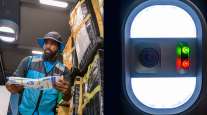The Seattle Times
Amazon Bringing Its Delivery Efficiency to Disaster Relief

[Stay on top of transportation news: Get TTNews in your inbox.]
When Abe Diaz woke up one February morning, his mind was in Turkey.
Working for Amazon from his Kenmore, Wash., home, Diaz was dreaming of ways to speed up the delivery process — but he wasn’t thinking about typical online shoppers. Instead, he was searching for sleeping bags to send to families who had just lost their homes, following a 7.8-magnitude earthquake that would ultimately kill more than 50,000 people in Turkey and Syria.
Diaz is used to addressing the aftermath of natural disasters — he starts every summer prepared to respond to up to three hurricanes in the U.S. alone — but this one had hit in the winter, half a world away.
Rather than sending diapers and other daily-use products, Diaz and his team were looking for camping gear, sleeping pads and blankets. Within days, the team had mentally switched time zones and ended up sending two fully loaded cargo planes with more than 100,000 pounds of goods.

Camping supplies are sorted by an Amazon worker. (Amazon)
Diaz leads Disaster Relief by Amazon, a group of Amazon employees tasked with using the company’s resources to help communities after disasters strike. Those resources range from unused warehouse space to an air transportation system to cloud computing power in order to gather insights about the scene on the ground. When disaster hits, the team of two swells to include employees from Amazon’s other departments, like Amazon Web Services and Amazon Air.
“We build all this machinery, infrastructure [and] technology that has to do with fulfilling customer needs very quickly,” Diaz said. “We feel there’s a second ROI [return on investment] ... that has to be built.”
Seattle-based Amazon, which ranks No. 9 on the Transport Topics Top 100 list of the largest private carriers in North America, has invested tens of millions of dollars in its disaster-relief program since its launch six years ago. It has donated 23 million items to victims of 113 natural disasters.

Abe Diaz, on using Amazon's logistics infrastructure for a greater good: “We feel there’s a second ROI [return on investment] ... that has to be built.” (Amazon)
The team has worked in disaster-stricken locations across the U.S. and the world, from California, Mississippi and Tennessee to Pakistan, Indonesia and Ukraine. They helped residents of Maui after deadly wildfires devastated the island last month. They went east of Seattle as wildfires consumed parts of Spokane County earlier this summer. They took trips to Puerto Rico, which were especially meaningful for Diaz, who was born and raised there.
After Hurricane Maria hit the territory in 2017, Diaz didn’t hear from his family for days. “I can lead with empathy because of that,” he said. “I’ve been in those shoes. I understand what it feels like.
“You can’t tell people to just move away, it’s not possible. We need to be able to help reach communities in the ways they need.”
Amazon’s meteorologist
Every Tuesday and Thursday, Victor Rodriguez tries to beat the Weather Channel.
As Amazon’s first operational meteorologist, Rodriguez acts somewhat as the company’s watchtower to send the first flare if inclement weather could affect operations.
Rodriguez hosts a call twice a week for 30 Amazon employees — from different departments and different parts of North America — to talk about the weather. His reports could signal to warehouse managers that sidewalks could be icy and delivery drivers should be extra cautious. Or, his reports could help the disaster relief team prepare for a trip to deliver aid after a hurricane, ensuring they are landing in an area that isn’t at risk of a power outage. Or, the reports could alert the company that high winds could shut down some operations.

Unused warehouse space is pressed into duty for disaster relief storage. (Amazon)
Rodriguez likes to say he has to beat the weatherman because so many people use apps or other forecasting tools to track the weather. But his role is to predict risk even further out — giving the company more notice and time to prepare.
Most of the time “weather is going to have a negligible impact,” Rodriguez said. “But there’s that 10% uncertainty. I’m there when you get to that 2% range when you start looking at the negative impact.”
Amazon, Walmart and other large retailers are bringing meteorologists on board, Rodriguez said, because “with the uncertainty in climate change, you’re seeing more impacts” on businesses and operations.
Amid an increased focus on the climate, Amazon has taken steps to reduce its impact on the environment, from purchasing renewable energy to run its data centers to cutting packaging material from its waste stream to installing hydrogen-powered forklifts in warehouses and battery-powered generators in its trailers on TV and movie sets.
Still, some advocates have called on the company to do more, including asking Amazon to commit to reducing its plastic use and push up some timelines for sustainability goals. Corporate employees have staged two walkouts — one in 2019 and one in May — asking their employer to take action.
Curious how The Disaster Relief by Amazon team operates? Read how they acted immediately to provide relief supplies to those affected by #HurricaneDorian in September. https://t.co/YDpksvefNT pic.twitter.com/l54uXr46bI — Amazon (@amazon) October 10, 2019
Amazon’s carbon footprint totaled more than 71 million metric tons last year, and the company recently lost an endorsement from the world’s leading watchdog of corporate climate goals for failing to set a credible target for reducing emissions.
Asked about the dichotomy between Amazon’s impact on the environment and the company’s efforts to help after disaster strikes, Rodriguez and Diaz pointed to Amazon’s sustainability team, the group behind efforts to electrify its delivery fleet and reduce the amount of packaging used to ship orders.
Rodriguez said every company has its flaws, but he considers Amazon “generally a driver of positive change.”
Diaz said, talking about his own team, “we support our communities ... because it’s the right thing to do.”
‘Always on the Edge’
When Hurricane Maria made landfall in Puerto Rico in 2017, Diaz was working as a computer engineer for Prime Video.
Searching for ways to help his family, he sent an email to hundreds of co-workers in Amazon’s Seattle offices, outlining a plan for support and asking others to join his effort. Several colleagues pointed him to Bettina Stix, a longtime Amazon employee who had just started a new team designed solely to help with disaster relief.
Amazon's disaster relief team taps into existing resources to help disaster-stricken communities. Team leader Abe Diaz reflects on his personal experience. https://t.co/lNrsJEtRI8 — The Seattle Times (@seattletimes) September 10, 2023
Diaz knocked on Stix’s door one day and returned to his engineering job three weeks later, after camping out in her office and helping organize a flight to Puerto Rico filled with supplies.
Two years later, Diaz joined the team full time. Within a few months, he was following Hurricane Dorian to the Bahamas. Since then, “it just hasn’t stopped.”
Diaz and his team spend their days monitoring weather events, keeping an eye on what could turn devastating and communicating with partners on the ground to make sure they have supplies on hand. The team aims to predict needs as early as possible so they can send aid as quickly as possible.
“This is not really a defined job,” Diaz said. “And that’s because the nature of disasters is not defined.”
Diaz splits events into two buckets: notice and no-notice. A hurricane is considered a notice event because there are days to prepare as meteorologists watch the storm’s path. An earthquake is considered no-notice.
That means Amazon’s relief efforts also fall into two categories: proactive and reactive. The company has the “biggest opportunity” to help proactively, Diaz said, because they can make investments early on, pre-position products that communities are likely to need and open lines of communication with the groups on the ground in advance.

An Amazon worker applies a humanitarian goods label to a shipment destined to assist disaster victims. (Amazon)
Some events fall into more than one category. In Maui, for example, the hurricane was expected, but no one could have predicted the wildfire that followed, Diaz said.
“I’m always on the edge,” he said. Sometimes, “I look at my wife, and she’s like, ‘I lost my husband for a week.’ She knows what’s coming. This is not easy work. ... The emotional toll it takes is not trivial.”
There have been donations no one wants to talk about, he continued. If a health department asks for body bags, the disaster relief team finds a way to source them.
There have also been innovative donations, said Colin Peterson, the chief development officer for the American Red Cross, Northwest Region, who works with Diaz and Amazon’s disaster relief team.
Amazon provided kits to help prepare for wildfire season — including shovels, rakes, sifters, gloves and masks. It also helped supply “sensory comfort kits” for adults and children who are on the autism spectrum, packing a backpack with noise-canceling headphones, a weighted blanket and a small tent so people can “have their own space for respite” in a crowded shelter, Peterson said.
In the last year, Diaz worked with the Red Cross to change the type of batteries it uses in flashlights — switching from D batteries to LED — to make the equipment lighter to carry and ship and last longer.
In Maui, Amazon’s disaster-relief program donated 3,000 solar-powered lights, 400 tents, 400 air mattresses, sheet sets and pillows, 200 COVID-19 tests and 60,000 biodegradable clamshells to be used for food service. The company also sent $30,000 for wheelchairs and $100,000 in gift cards for local organizers to spend as needed.
Echoing Amazon’s mantra of “customer obsession,” Diaz said his team has obsessed over how to “compress the timeline of relief.” And it has worked.
Want more news? Listen to today's daily briefing above or go here for more info
When Hurricane Maria hit Puerto Rico nearly six years ago, it took 14 days to find the right products, consolidate them, put them on a flight and coordinate with local groups to get the items to those in need. When Hurricane Fiona hit the same territory last September, the process took five days. Diaz wants to trim that response time down to three days.
He’s been back to Puerto Rico since he started working on Amazon’s disaster relief team. Most recently, he went to help set up a new type of facility where Amazon is partnering with a local group to operate a pickup location for products. Diaz remembers talking about a similar concept back in 2017. “Seeing some of the newer solutions, seeing some of the new projects come to life after thinking about them ... it’s just a sense of ‘it’s so rewarding.’ It’s hard to explain,” he said.
“Myself and my team, we’re so connected to the work we do,” he continued. “We’ve seen the outcomes — we know what we can do.”
Distributed by Tribune Content Agency, LLC




